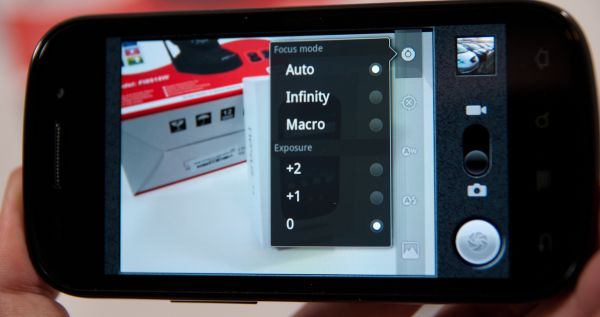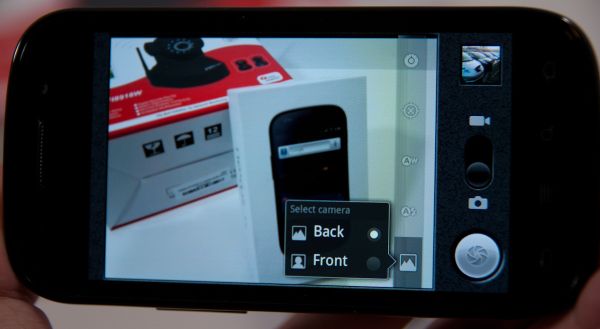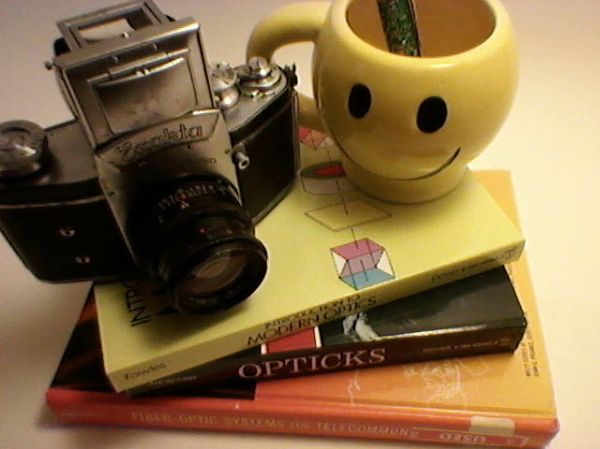Nexus S and Android 2.3 Review: Gingerbread for the Holidays
by Brian Klug on December 14, 2010 4:08 PM EST- Posted in
- Smartphones
- Samsung
- Nexus S
- Gingerbread
- Android 2.3
- Mobile
Camera Analysis
If there’s anything to be learned in a straight comparison between the Nexus One and Nexus S, it’s again that megapixels don’t matter. I never was a huge fan of the Nexus One camera - there’s a strange undersaturation in some images, and that extra glare from having another layer of plastic between the lens and your object where grime could collect.
The Nexus S is overall much improved, but still not perfect. Again, the obvious analogue here is to the Galaxy S, but side by side quality on the Fascinate looks markedly superior in our lights-on test. With the lights off and the flash set to auto, the Nexus S is much improved. The reason is that the stock camera now correctly illuminates the object while running the autofocus routine - the result is that in the dark shots are now focused properly. Further, you get an idea for whether the flash reaches far enough to actually do any good. Kudos to Google for fixing this.
Even more Kudos, however, for adding some manual focus settings. Tap on the settings button, and you can select from Auto, Infinity, and Macro. Objects beyond hyperfocal distance are essentially in focus when the camera is focused to infinity, so if you’re shooting photos beyond a certain distance and don’t want to bother with wasting time focusing, infinity is super useful. Likewise, macro gets you the closest possible focus.
The back facing camera isn’t the best we’ve seen, but it’s an improvement from the Nexus One. In our lightbox test, there’s still a lot of missing dynamic range and detail in the texture on the Exacta camera, but there’s so much more contrast compared to the Nexus One.
I took photos in our bench location, in the light box with lights on and off, and then just casually while I carried it around.
There’s also a button along the row of other camera settings buttons for changing to the front facing camera. When you’re in the front facing camera, a few options go away. You can’t change resolution, and focus controls are also obviously gone since the camera is fixed focus. Resolution is VGA. Quality on the front facing camera isn’t spectacular, but then again the aperture diameter on that camera is barely 1 mm. The front facing camera also flips-images horizontally after capture.
What’s odd about the Nexus S is that video encoding is only 720x480, not the HD 720P we’re used to seeing with the Galaxy S. Video is encoded in H.264 with AAC audio, at an average bitrate of 3,664 kilobits/s on the back camera. The front camera records at 640x480 with the same codecs at just over 1 megabit/s.
I noticed that audio doesn’t quite sync up in the front facing camera video, which is a bit unnerving to say the least. The back camera is fine, and seems relatively smooth. Not having 720P is a disappointment, hopefully someone unlocks HD recording on the Nexus S same as was done on the Nexus One. It certainly isn’t a matter of the SoC not being powerful enough if Galaxy S can do it.
I took a video with the front and back facing camera at our usual location:
Rear Camera:
Front Camera:
And one more video in a different location per some commenters asking for an indoor to outdoor progression for gauging quality.





































73 Comments
View All Comments
metafor - Wednesday, December 15, 2010 - link
That's a bit misleading. There are a few versions of the "lagfix" around and not all of them simply change the filesystem. A bunch actually turn on memory caching, which essentially uses DRAM to cache disk IO.This is what causes the gigantic jump in Quadrant scores you see. In reality, while the fileIO portion of quadrant does artificially lower the Galaxy S's end-score, it's nowhere near by the amount many who apply the patch sees.
daveloft - Wednesday, December 15, 2010 - link
I'm running 2.2 which boosted my score from 800 - 1100.I also use a lagfix to change my file system to EXT4 which boosted my score from 1100 - 1600.
It's by no means misleading. I know there's lots of other lagfixes and optimizations and custom kernels. It doesn't take away from my point that Quadrant is heavily influenced by file system and as a result of running a different file system on my Galaxy S I a significantly boost in my score.
daveloft - Wednesday, December 15, 2010 - link
The people touting their 2000 plus scores on their Galaxy S are the ones likely doing what you said. But again that comes back to my point that modifying your phone for better IO performance will make your Quadrant score significantly better and any device with really fast storage will benefit from a high Quadrant score. This will lead people to say that the Snapdagron chip is better.metafor - Thursday, December 16, 2010 - link
A lot of people make a lot of claims without isolating the chip. I remember the "A4 vs Snapdragon" and all the wild conjecture that went into that.As for the original comment, I think at least the 45nm Snapdragons are comparable, almost indistinguishable from the current gen Hummingbirds. With the exception of perhaps the FP/SIMD performance -- which no programs today use anyway.
One thing I would like to see is someone try to test these chips for power usage in isolation. A Hall-style current monitor and an integrating voltage monitor should be sufficient to know just how much power these chips use. Of course that means taking the device apart and still have it operating.
zorxd - Tuesday, December 14, 2010 - link
Works just fine here with android 2.2. WPA2+PEAP+MSchapv2Brian Klug - Tuesday, December 14, 2010 - link
So I think the story with the Nexus One was that it was working in 2.2, but disappeared in 2.2.1. I know that for some months now I've been unable to authenticate with that same network with the Nexus One.Some of the other devices have better WPA supplicants too I guess.
-Brian
Shadowmaster625 - Tuesday, December 14, 2010 - link
If you phone is laying on a book, the camera lens is about 3 mm away from the page and the viewing angle is about 3 of those letters. Not to mention there is no light getting under there. So how can the screen be showing all those characters?Brian Klug - Tuesday, December 14, 2010 - link
Oh so when I took that photo, I was worried someone would be misled, apologies, didn't mean to confuse. I just took a photo a few inches from the page, then set it as the wallpaper, then snapped the picture.What's being shown isn't camera input. ;)
-Brian
sabrewulf - Tuesday, December 14, 2010 - link
"Things like scrollback and sending cursor commands in connectbot (arguably Android’s best SSH application) simply require having some directional controls - there’s no virtual keyboard with arrow keys. "Using the Swype keyboard, if you swype from the swype button to the sym button and release, you are given a virtual keyboard with arrow keys, pgup/dn, home/end, and a few other functions.
Brian Klug - Tuesday, December 14, 2010 - link
Oh wow, I totally missed that in Swype. Awesome tip!-Brian